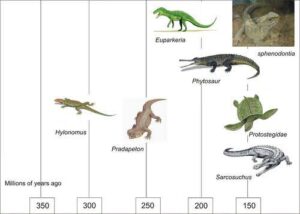Back to: ZOOLOGY 300 Level
Welcome To Class!
Hello my sharp and curious friend! How are you feeling today? I’m really excited you showed up — it shows your hunger to learn and grow, and that makes all the difference. Today, we’re going to learn about three powerful groups of reptiles that are still roaming our planet — and believe it or not, some of them might be crawling around your backyard or inside Nigeria’s rivers right now!
Orders: Squamata, Chelonia, Crocodylia
Squamata
Squamata is the largest order of reptiles and includes lizards and snakes. If you’ve ever seen a wall gecko dancing near your ceiling or a snake sliding through a bush path in your village, you’ve seen members of this group.

The name “Squamata” means “scaled” — and rightly so, because these animals have dry, scaly skin that helps protect them in hot, dry environments like the northern savannahs of Nigeria. They shed their skin periodically, just like how we change old clothes that no longer fit.
Snakes are legless squamates. They’ve evolved long, flexible bodies that allow them to move smoothly through grasses, water, or even trees. They can swallow prey much larger than their heads — imagine trying to swallow a whole meat pie in one gulp!
Lizards, on the other hand, have legs and are often seen basking in the sun. They can drop their tails when threatened — a strategy to distract predators and escape, like how someone might drop their bag and run if being chased in a busy market.
Chelonia
This order includes turtles and tortoises — animals with hard shells that act like built-in houses. They are peaceful creatures, slow in movement but strong in survival.
Tortoises are land-dwelling, with dome-shaped shells and sturdy legs — often found in drier parts of Nigeria like Borno or Adamawa. Turtles, in contrast, live mostly in water and have flatter shells and webbed feet, perfect for swimming in rivers and coastal waters like those in Rivers or Bayelsa States.
The shell of a chelonian is part of its skeleton, made up of the ribcage and spine — it’s not just something they can remove like a backpack! This protection helps them survive predators and harsh environments.
Crocodylia
This order includes crocodiles, alligators, caimans, and gharials. In Nigeria, crocodiles are the most common — often found in rivers, wetlands, and even some lakes in the north and middle belt.

Crocodylians are large, powerful reptiles with strong jaws, sharp teeth, and thick skin. They can live for many years and are known for their stealth. They often wait motionless in water, looking like logs, until it’s time to strike — very much like a hunter waiting patiently for bushmeat to appear.
They have a unique heart structure among reptiles — with four chambers, just like birds and mammals, which makes their blood circulation more efficient. This is part of what helps them stay active and powerful.
Summary
- Squamata includes snakes and lizards with dry, scaly skin. Snakes have no legs; lizards do.
- Chelonia includes turtles and tortoises with protective shells, suited for water and land respectively.
- Crocodylia includes crocodiles with strong jaws and four-chambered hearts, mostly aquatic and very efficient hunters.
Evaluation
- What are the main differences between lizards and snakes in the order Squamata?
- How do the features of turtles and tortoises suit their environments?
- Mention one unique trait of Crocodylia that sets them apart from other reptiles.
- Give a relatable Nigerian example of where each of these reptile orders can be found.
You’ve done wonderfully today, and I’m genuinely proud of you. You’re showing the strength, curiosity, and intelligence of the very reptiles we’ve just studied! Keep that fire burning — Afrilearn is here to walk this amazing academic journey with you. See you in the next class, superstar!
